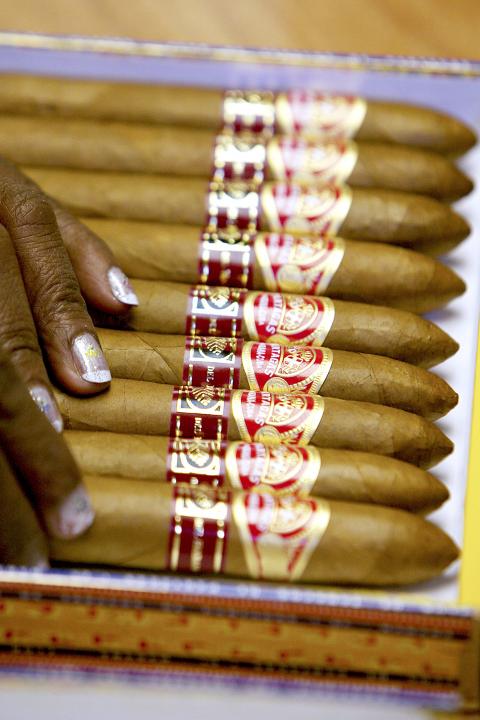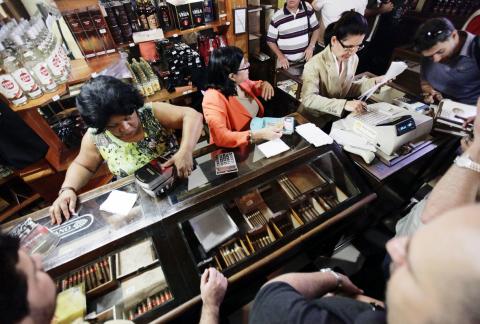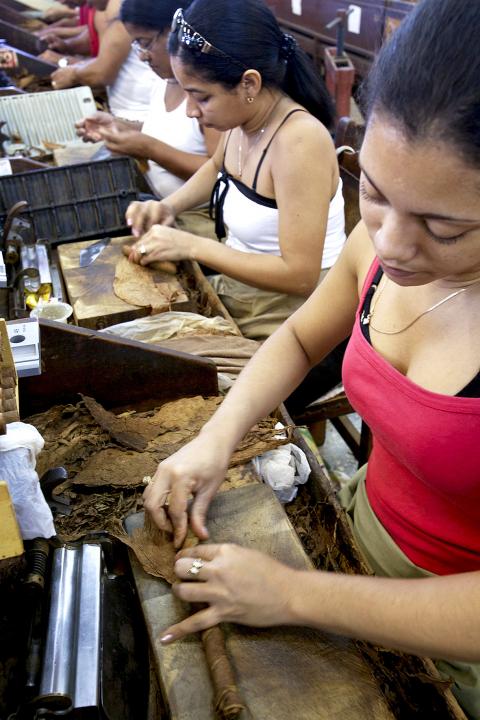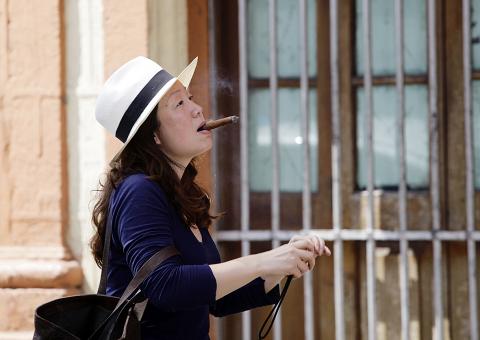Simon Chase, a British sage of the cigar world, stood in an elegant hotel salon here on Wednesday before a select group of aficionados, scrutinizing a box of 1970s cigars for evidence of their proclaimed vintage.
One clue, he said, was the style and quality of the seal on the box. Another was the cigars’ old-fashioned, slightly domed ends, or cabezas tumbada.
The group muttered with interest and lit up, using cedar strips, or spills, to avoid contaminating their cigars with lighter fumes. Gray wisps curled into the air, and a brief hush fell as they solemnly considered the US$90 smokes.

Photo: AGENCIES
The private tasting by some of Cuban tobacco’s most devoted connoisseurs took place on the fringe of Havana’s Cigar Festival, an annual, five-day whirl of grand receptions, talks and plantation visits organized by Habanos SA, a joint venture between the Cuban government and Britain’s Imperial Tobacco.
The event, much of which is staged at a gloomy 1970s convention center, is a somewhat surreal eruption of luxury in a landscape that, after five decades of Communist rule, is an odd melange of tropical exuberance and stern socialism. Cubans are inveterate smokers, and men and women alike suck on huge tabacos that cost about US$0.04. But with salaries of around US$20 per month, very few islanders could afford even the least expensive offerings from Habanos, whose retail prices on the international market can go as high as about US$80 apiece.
Still, the sale of cigars to wealthy foreigners helps bring in hard currency, which the government desperately needs to finance programs like health and education. At a lavish dinner held yesterday to close the festival, organizers hoped to raise as much as US$1 million for the Cuban public health system from the auction of humidors.

Photo: AGENCIES
“If you love cigars, Havana is what Jerusalem is to a Christian: the Holy Land,” said Bryan Ng, who owns an oyster bar in Hong Kong and was on his first visit to Cuba.
Some 1,200 retailers, distributors and enthusiasts flocked to the Cuban capital this week to fraternize and indulge their penchant for what many consider the world’s finest tobacco.
Among them was a sprinkling of American cigar lovers, who came through third countries or traveled on religious or humanitarian licenses, arriving in time for the festival. Habanos is banned from selling cigars to the US under the trade embargo, but the company says it accounts for about 80 percent of premium, hand-rolled cigar sales in the rest of the world.

Photo: AGENCIES
Paul Segal, who had his first cigar in Cuba in 2003 when he was on a humanitarian trip to help the island’s Jewish community, was making his fourth visit to the festival this week, bringing with him medicines and other supplies. At home in San Diego, he smokes Cuban cigars only occasionally, if someone brings them as a gift.
“I’m crazy obsessed for cigars,” he said during a master class where hundreds of participants learned to roll their own. “To see the whole process, from the seed to the leaves to the cigar factory, that’s very cool.”
The question of whether the huge American cigar market would open anytime soon hovered over the festival. Habanos officials said they were not banking on any change in American policy, despite the recent decision to further ease restrictions on travel by Americans.

Photo: AGENCIES
Chase, a consultant who was in the Cuban cigar trade for decades, said Cuba could, in theory, meet added demand from the US, if allowed. Any loss of cachet that would result from no longer being a forbidden product would be compensated for by added sales, he said.
“Lifting the embargo would cause some upheaval, but Cuba could handle it,” he said. “Cuban cigars compete on their own merit.”
Habanos’ sales have been hit in recent years by the global economic downturn and the spread of smoking restrictions to countries like Spain, its biggest market. But the company was upbeat this week, saying sales rose 2 percent last year, to US$368 million, as China overtook Germany as its number three customer.
The company, which owns well-known brands like Cohiba, Partagas and Romeo y Julieta, introduced some stubbier cigars this week that could be smoked more quickly by those forced to slip outside.
The festival is paradise for smokers who bridle under smoking bans. Participants puff their way through sommelier contests, fancy lunches and talks on cigar arcana, enveloping conference rooms and coffee bars in a thick haze of pungent smoke.
Participants held blindfold tastings in which experts tried to identify unlabeled cigars, and at other sessions tried pairing cigars with rum and chocolate. Chase even gave a 45-minute lecture Wednesday morning to a packed conference room on the history of the aluminum tubes used to package Cuban cigars — an account more lively than its subject matter would suggest.
“It’s an intense week: lots of caffeine, lots of tobacco” and no sleep, said Alex Iapichino, an Italian lawyer who hosted the private tasting.
Away from the fray, Wednesday’s coterie of connoisseurs determined that their 40-year-old cigar had been well preserved. It was a round, even smoke, they said, and had retained some delicate aromas.
Iapichino looked around the group, an eccentric mix from a dozen different countries that included a Japanese man who skewered his cigar on a custom-made metal pin to protect his fingers.
“This is the only place where I get to share cigars with all these people together,” he said.
When he left Cuba, his cigars would evoke the smells and sounds of the island, he said.
“As Churchill said,” he smiled. “I always have Cuba on my lips.”

The canonical shot of an East Asian city is a night skyline studded with towering apartment and office buildings, bright with neon and plastic signage, a landscape of energy and modernity. Another classic image is the same city seen from above, in which identical apartment towers march across the city, spilling out over nearby geography, like stylized soldiers colonizing new territory in a board game. Densely populated dynamic conurbations of money, technological innovation and convenience, it is hard to see the cities of East Asia as what they truly are: necropolises. Why is this? The East Asian development model, with

June 16 to June 22 The following flyer appeared on the streets of Hsinchu on June 12, 1895: “Taipei has already fallen to the Japanese barbarians, who have brought great misery to our land and people. We heard that the Japanese occupiers will tax our gardens, our houses, our bodies, and even our chickens, dogs, cows and pigs. They wear their hair wild, carve their teeth, tattoo their foreheads, wear strange clothes and speak a strange language. How can we be ruled by such people?” Posted by civilian militia leader Wu Tang-hsing (吳湯興), it was a call to arms to retake

This is a deeply unsettling period in Taiwan. Uncertainties are everywhere while everyone waits for a small army of other shoes to drop on nearly every front. During challenging times, interesting political changes can happen, yet all three major political parties are beset with scandals, strife and self-inflicted wounds. As the ruling party, the Democratic Progressive Party (DPP) is held accountable for not only the challenges to the party, but also the nation. Taiwan is geopolitically and economically under threat. Domestically, the administration is under siege by the opposition-controlled legislature and growing discontent with what opponents characterize as arrogant, autocratic

When Lisa, 20, laces into her ultra-high heels for her shift at a strip club in Ukraine’s Kharkiv, she knows that aside from dancing, she will have to comfort traumatized soldiers. Since Russia’s 2022 invasion, exhausted troops are the main clientele of the Flash Dancers club in the center of the northeastern city, just 20 kilometers from Russian forces. For some customers, it provides an “escape” from the war, said Valerya Zavatska — a 25-year-old law graduate who runs the club with her mother, an ex-dancer. But many are not there just for the show. They “want to talk about what hurts,” she